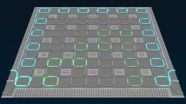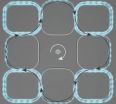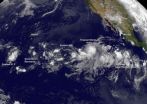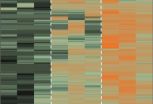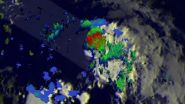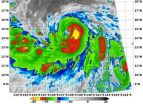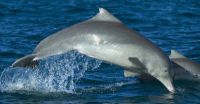(Press-News.org) Topological transport of light is the photonic analog of topological electron flow in certain semiconductors. In the electron case, the current flows around the edge of the material but not through the bulk. It is "topological" in that even if electrons encounter impurities in the material the electrons will continue to flow without losing energy.
In the photonic equivalent, light flows not through and around a regular material but in a meta-material consisting of an array of tiny glass loops fabricated on a silicon substrate. If the loops are engineered just right, the topological feature appears: light sent into the array easily circulates around the edge with very little energy loss (even if some of the loops aren't working) while light taking an interior route suffers loss.
Mohammad Hafezi and his colleagues at the Joint Quantum Institute have published a series of papers on the subject of topological light. The first pointed out the potential application of robustness in delay lines and conceived a scheme to implement quantum Hall models in arrays of photonic loops. In photonics, signals sometimes need to be delayed, usually by sending light into a kilometers-long loop of optical fiber. In an on-chip scheme, such delays could be accomplished on the microscale; this is in addition to the energy-loss reduction made possible by topological robustness (1).
The next paper reported on results from an actual experiment. Since the tiny loops aren't perfect, they do allow a bit of light to escape vertically out of the plane of the array (2). This faint light allowed the JQI experimenters to image the course of light. This confirmed the plan that light persists when it goes around the edge of the array but suffers energy loss when traveling through the bulk.
The third paper, appearing now in Physical Review Letters, actually delivers detailed measurements of the transmission (how much energy is lost) and delay for edge-state light and for bulk-route light (3). The paper is notable enough to have received an "editor's suggestion" designation. "Apart from the potential photonic-chip applications of this scheme," said Hafezi, "this photonic platform could allow us to investigate fundamental quantum transport properties."
Another measured quality is consistency. Sunil Mittal, a graduate student at the University of Maryland and first author on the paper, points out that microchip manufacturing is not a perfect process. "Irregularities in integrated photonic device fabrication usually result in device-to-device performance variations," he said. And this usually undercuts the microchip performance. But with topological protection (photons traveling at the edge of the array are practically invulnerable to impurities) at work, consistency is greatly strengthened.
Indeed, the authors, reporting trials with numerous array samples, reveal that for light taking the bulk (interior) route in the array, the delay and transmission of light can vary a lot, whereas for light making the edge route, the amount of energy loss is regularly less and the time delay for signals more consistent. Robustness and consistency are vital if you want to integrate such arrays into photonic schemes for processing quantum information.
How does the topological property emerge at the microscopic level? First, look at the electron topological behavior, which is an offshoot of the quantum Hall effect. Electrons, under the influence of an applied magnetic field can execute tiny cyclonic orbits. In some materials, called topological insulators, no external magnetic field is needed since the necessary field is supplied by spin-orbit interactions---that is, the coupling between the orbital motion of electrons and their spins. In these materials the conduction regime is topological: the material is conductive around the edge but is an insulator in the interior.
And now for the photonic equivalent. Light waves do not usually feel magnetic fields, and if they do it is very weak. In the photonic case, the equivalent of a magnetic field is supplied by a subtle phase shift imposed on the light as it circulates around the loops. Actually the loops in the array are of two kinds: resonator loops designed to exactly accommodate light at a certain frequency, allowing the waves to circle the loop many times. Link loops, by contrast, are not exactly suited to the waves, and are designed chiefly to pass the light onto the neighboring resonator loop.
Light that circulates around one unit cell of the loop array will undergo a slight phase change, an amount signified by the letter phi. That is, the light signal, in coming around the unit cell, re-arrives where it started advanced or retarded just a bit from its original condition. Just this amount of change imparts the topological robustness to the global transmission of the light in the array.
In summary, documented on-chip light delay and a robust, consistent, low-loss transport of light has now been demonstrated. The transport of light is tunable to a range of frequencies and the chip can be manufactured using standard micro-fabrications techniques.
INFORMATION:
1. Concept for making on-chip delay lines: http://jqi.umd.edu/news/miniaturizing-delay-lines
2. Topological light observed in 2D arrays: http://jqi.umd.edu/news/topological-light
3. "Topologically Robust Transport of Photons in a Synthetic Gauge Field," S. Mittal, J. Fan, S. Faez, A. Migdall, J. M. Taylor, and M. Hafezi, Physical Review Letters, to be published in August 2014; archive version: http://arxiv.org/pdf/1404.0090v1.pdf
Mohammad Hafezi, Hafezi@umd.edu; Sunil Mittal, mittals@umd.edu
Press contact at JQI: Phillip F. Schewe, pschewe@umd.edu, 301-405-0989. http://jqi.umd.edu/
On-chipt topological light
First measurements of transmission and delay
2014-08-01
ELSE PRESS RELEASES FROM THIS DATE:
Society bloomed with gentler personalities and more feminine faces
2014-08-01
DURHAM, N.C. -- Modern humans appear in the fossil record about 200,000 years ago, but it was only about 50,000 years ago that making art and advanced tools became widespread.
A new study appearing Aug. 1 in the journal Current Anthropology finds that human skulls changed in ways that indicate a lowering of testosterone levels at around the same time that culture was blossoming.
"The modern human behaviors of technological innovation, making art and rapid cultural exchange probably came at the same time that we developed a more cooperative temperament," said lead author ...
History of culture visualized through art history, physics, complexity
2014-08-01
Coral Gables, Fla. (July 31, 2014) -- Quantifying and transforming the history of culture into visual representation isn't easy. There are thousands of individual stories, across thousands of years, to consider, and some historical conditions are nearly impossible to measure.
Addressing this challenge, Dr. Maximilian Schich, associate professor of arts and technology at The University of Texas at Dallas, brought together a team of network and complexity scientists, including University of Miami physicist Chaoming Song, to create and quantify a big picture of European ...
'Normal' bacteria vital for keeping intestinal lining intact
2014-08-01
August 1, 2014 — (BRONX, NY) — Scientists at Albert Einstein College of Medicine of Yeshiva University have found that bacteria that aid in digestion help keep the intestinal lining intact. The findings, reported online in the journal Immunity, could yield new therapies for inflammatory bowel disease (IBD) and a wide range of other disorders.
The research involved the intestinal microbiome, which contains some 100 trillion bacteria. The role of these microorganisms in promoting or preventing disease is a major emerging field of study. Einstein scientists found that absorption ...
A train of 5 tropical cyclones in the Central and Eastern Pacific
2014-08-01
A train of developing tropical low pressure areas stretch from the Eastern Pacific Ocean into the Central Pacific and they were captured in an image from NOAA's GOES-West satellite on August 1. The train of five tropical lows include the remnants of Tropical Storm Genevieve and newly developed Tropical Storm Iselle.
NOAA's GOES-West satellite captured an image of the Pacific Ocean on August 1 at 1200 UTC (8 a.m. EDT) that showed post-tropical cyclone Genevieve's remnants between three other systems. The GOES-West image shows the train of storms with a well-developed Iselle ...
A map for eye disease
2014-08-01
Understanding eye diseases is tricky enough. Knowing what causes them at the molecular level is even more confounding.
Now, University of Iowa researchers have created the most detailed map to date of a region of the human eye long associated with blinding diseases, such as age-related macular degeneration. The high-resolution molecular map catalogs thousands of proteins in the choroid, which supplies blood and oxygen to the outer retina, itself critical in vision. By seeing differences in the abundance of proteins in different areas of the choroid, the researchers can ...
NASA finds heavy rainfall and wind shear in newborn Tropical Storm Bertha
2014-08-01
VIDEO:
This 3-D flyby of Tropical Storm Bertha on Aug. 1 was created from TRMM satellite data. It shows (from the south) intense thunderstorms were reaching heights of over 15km (about...
Click here for more information.
The Tropical Rainfall Measuring Mission satellite known as TRMM found rain was falling heavily in the Atlantic Ocean's second tropical storm of the hurricane season. Bertha was close to the Lesser Antilles, prompting warnings and watches.
The National Hurricane ...
Reptile Database surpasses 10,000 reptile species
2014-08-01
More than 10,000 reptile species have been recorded into the Reptile Database, a web-based catalogue of all living reptile species and classification, making the reptile species among the most diverse vertebrate groups in the world, alongside bird and fish species.
For some time, experts have projected that 2014 would mark the year that reptiles would become the most diverse vertebrate group in the world. Reptiles include snakes, lizards, turtles, crocodiles, tuataras and amphisbaenians.
"Officially, we have logged 10,038 reptile species into the database, which is ...
NASA sees Tropical Storm Halong's 'best side'
2014-08-01
NASA satellite data showed Tropical Storm Halong's "best side" or most powerful side was east of its center. That's where the coldest cloud top temperatures and strongest thunderstorms appeared on satellite imagery.
On August 1 at 13:30 UTC (9:30 a.m. EDT) the Moderate Resolution Imaging Spectroradiometer or MODIS instrument aboard NASA's Terra satellite captured an infrared picture of Tropical Storm Halong. The infrared data showed the coldest, strongest thunderstorm cloud-top temperatures east of the center of circulation. Cloud tops were as cold as -80F/-62C. Cloud ...
Advances in assisted reproduction create more options & new legal issues for LGBT couples
2014-08-01
New Rochelle, NY, August 1, 2014—Lesbian, gay, bisexual, and transgender individuals who want to conceive a child may face the same problems as some of their heterosexual and cisgendered peers, such as reduced fertility, but in addition they often face additional physiological and legal challenges to become parents. A comprehensive review of the most recent advances in assisted reproduction options is presented in the article "LGBT Assisted Reproduction: Current Practice and Future Possibilities," published in LGBT Health, a peer-reviewed journal from Mary Ann Liebert, ...
Scientists name new species of cetacean: The Australian humpback dolphin
2014-08-01
Scientists examining a taxonomically confused group of marine mammals have officially named a species new to science: the Australian humpback dolphin, Sousa sahulensis, according to the Wildlife Conservation Society and Clymene Enterprises.
The study describing the newly named species is the culmination of a 17-year long systematic examination of all available historical records, physical descriptions, and genetic data of humpback dolphins—a widespread group of coastal cetaceans ranging from the coast of West Africa to the northern coast of Australia. The Australian ...
LAST 30 PRESS RELEASES:
Jeonbuk National University study shows positive parenting can protect adolescents against self-harm
Surface-engineered ZnO nanocrystals to tackle perfluoroalkyl substance contamination
This new understanding of T cell receptors may improve cancer immunotherapies
A new fossil face sheds light on early migrations of ancient human ancestor
A new immunotherapy approach could work for many types of cancer
A new way to diagnose deadly lung infections and save lives
40 percent of MRI signals do not correspond to actual brain activity
How brain-inspired algorithms could drive down AI energy costs
Gum disease may be linked to plaque buildup in arteries, higher risk of major CVD events
Contrails are a major driver of aviation’s climate impact
Structure of dopamine-releasing neurons relates to the type of circuits they form for smell-processing
Reducing social isolation protects the brain in later life
Keeping the heart healthy increases longevity even after cancer
Young adults commonly mix cannabis with nicotine and tobacco
Comprehensive review illuminates tau protein's dual nature in brain health, disease, and emerging psychiatric connections
Book prepares K-12 leaders for the next public health crisis
Storms in the Southern Ocean mitigates global warming
Seals on the move: Research reveals key data for offshore development and international ecology
Sports injuries sustained during your period might be more severe
World's first successful 2 Tbit/s free-space optical communication using small optical terminals mountable on satellites and HAPS
Can intimate relationships affect your heart? New study says ‘yes’
Scalable and healable gradient textiles for multi‑scenario radiative cooling via bicomponent blow spinning
Research shows informed traders never let a good climate crisis go to waste
Intelligent XGBoost framework enhances asphalt pavement skid resistance assessment
Dual-function biomaterials for postoperative osteosarcoma: Tumor suppression and bone regeneration
New framework reveals where transport emissions concentrate in Singapore
NTP-enhanced lattice oxygen activation in Ce-Co catalysts for low-temperature soot combustion
Synergistic interface engineering in Cu-Zn-Ce catalysts for efficient CO2 hydrogenation to methanol
COVID-19 leaves a lasting mark on the human brain
Scientists use ultrasound to soften and treat cancer tumors without damaging healthy tissue
[Press-News.org] On-chipt topological lightFirst measurements of transmission and delay
